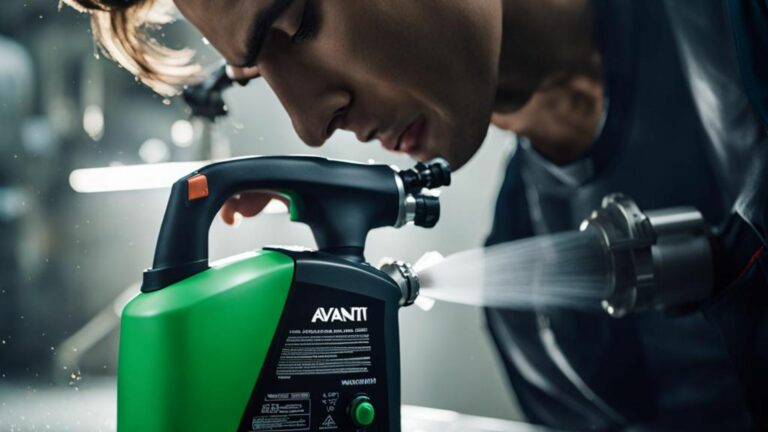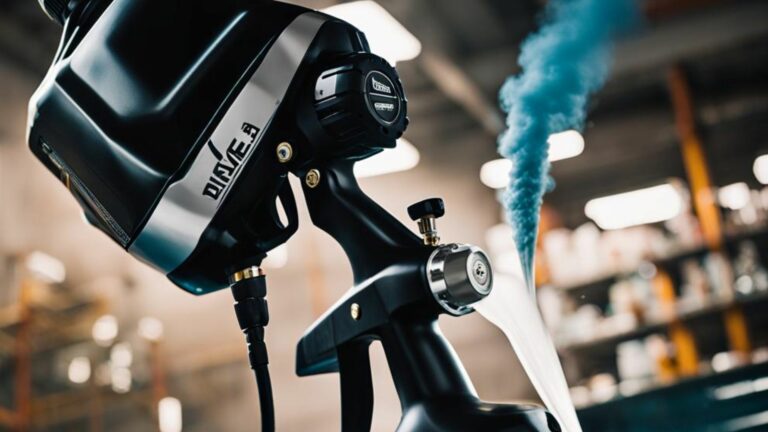
To use a Yattich HVLP paint sprayer, fill the container with paint, then connect the air hose and power supply before adjusting the spray pattern.
Turn on the device, test the spray on cardboard, and then apply evenly to your desired surface.
Exploring the capabilities of the Yattich HVLP paint sprayer reveals a transformative approach to painting tasks.
This handy tool ensures a fine finish with reduced overspray, making it a favorite among DIY enthusiasts and professional painters.
It’s crucial to start by selecting the right nozzle and meticulously tweaking the flow controls to suit the viscosity of your paint.
Preparing the surface and the surrounding area is essential to achieving the best results and maintaining a clean workspace.
Once these steps are complete, the sprayer becomes an extension of your hand, providing a consistent, even coat across various surfaces.
This introduction sets the stage for an effortless and efficient painting experience, emphasizing readiness, precision, and technique.
Understanding Yattich HVLP Paint Sprayer
Embarking on a painting project can be daunting, but the Yattich HVLP (High Volume, Low Pressure) Paint Sprayer simplifies the process, offering precision and efficiency.
Let’s delve into what makes an HVLP paint sprayer a must-have tool and discover the unique features of the Yattich model, ensuring your next painting venture is seamless and professional.
What is an HVLP Paint Sprayer?
The HVLP paint sprayer stands out for its ability to deliver a high volume of paint at a low pressure. This ingenious design drastically reduces overspray and waste while ensuring a uniform application.
Ideal for both novices and experts, the HVLP sprayer makes achieving a smooth, high-quality finish on a range of surfaces easier than ever.
Introducing the Yattich HVLP Paint Sprayer
Enter the world of easy and efficient painting with the Yattich HVLP Paint Sprayer. Designed to excel, this sprayer combines all the benefits of HVLP technology with user-friendly features tailored to enhance your painting experience.
Whether tackling indoor furniture, cabinets, or outdoor projects, the Yattich sprayer performs exceptionally well across various tasks.
Key Features of Yattich HVLP Paint Sprayer
- Adjustable Flow Control: Tailor your spray output to suit specific project needs.
- Versatile Nozzle Sizes: Multiple nozzle options for different paint types and finishes exist.
- Easy to Clean: Features a detachable design for hassle-free cleaning.
- Long Power Cord: Offers extensive reach for large workspaces.
DIY enthusiasts and professionals benefit from the Yattich HVLP Paint Sprayer’s precise control and exceptional versatility.
This paint sprayer saves time and paint and delivers consistent results with an admirable finish.
Preparing for Yattich HVLP Paint Sprayer
The Yattich HVLP (High Volume Low Pressure) paint sprayer is a game-changer for DIY enthusiasts and professional painters.
To ensure a flawless finish, proper preparation is key.
This includes selecting the right paint, preparing the surface, and correctly setting up the Yattich HVLP sprayer. Follow these steps meticulously to achieve the best results with your paint job.
Choosing the Right Paint for HVLP Spraying
The appropriate paint for your HVLP sprayer is crucial for optimum performance and finish. Here are the factors to consider:
- Viscosity: HVLP sprayers perform best with thinner paints. Check the paint’s viscosity and thin it accordingly.
- Type of Paint: Latex, acrylics, and enamels can be used, but avoid thicker, textured types unless your sprayer is specifically designed for them.
- Quality: Invest in high-quality paint to prevent clogging and to ensure a smooth finish.
Preparing the Surface for Painting
A pristine surface is vital for a professional finish. Here’s how to prepare:
- Clean: Wash the surface to remove dust, grime, and oils. Allow to dry completely.
- Sand: For wood or previously painted surfaces, sanding promotes adhesion.
- Prime: Apply a primer to ensure paint adherence and longevity.
- Mask: Use quality painter’s tape to protect areas not intended for painting.
Setting Up the Yattich HVLP Paint Sprayer
Proper setup is essential for the Yattich HVLP sprayer to function effectively. Follow these guidelines:
- Assemble the Sprayer: Connect the gun to the air hose and adjust the nozzle to the desired spray pattern.
- Test the Flow: Perform a test spray on a piece of cardboard to ensure smooth paint flow.
- Dial in Settings: Adjust the pressure and volume controls for an even spray, minimizing overspray and paint waste.
Using Yattich HVLP Paint Sprayer
The Yattich HVLP Paint Sprayer stands as a game-changer in DIY painting projects. With its high-volume, low-pressure technology, this sprayer ensures a smooth, professional finish with minimal overspray.
Learning to wield this tool effectively can be the difference between a tedious paint job and a fun, satisfying endeavor.
Let’s dive into the intricacies of adjusting the spray patterns and pressure, mastering the painting techniques, and abiding by the safety measures to bring out the best in your Yattich HVLP Paint Sprayer.
Adjusting Spray Patterns and Pressure
Adjusting spray patterns and pressure on your Yattich spray gun allows for precise control and flawless application.
Three main spray patterns – horizontal, vertical, and circular – can be achieved by twisting the nozzle. Crucial tips include:
- For horizontal surfaces, opt for a vertical spray pattern.
- Vertical surfaces benefit from a horizontal pattern to ensure even coverage.
- Detailed work requires a circular pattern for a more directed finish.
Maintaining ideal pressure is vital for the sprayer’s efficiency. Start with the recommended setting and adjust gradually, aiming for a consistent spray without drips or uneven patterns.
Techniques for Using the Yattich HVLP Paint Sprayer
Perfecting your technique is essential for harnessing the full potential of the Yattich HVLP Paint Sprayer. Crucial aspects to remember include:
- Maintain a consistent distance of 6–8 inches from the surface.
- Keep the sprayer moving at a steady pace to avoid runs and sags.
- Overlap each pass by about 50% to ensure even coverage.
- Apply thin coats, adding layers for desired opacity and finish.
You’ll develop a steady hand with practice, ensuring professional results every time.
Safety Precautions and Best Practices
Safety precautions are the cornerstone of any painting project. Equip yourself with safety glasses, gloves, and a respirator to protect from fumes and overspray. Additionally, ensure ample ventilation in your workspace.
Some best practices for using the Yattich HVLP Paint Sprayer include:
- Test the sprayer on a piece of cardboard before starting.
- Strain the paint to prevent clogs in the sprayer nozzle.
- Clean the sprayer thoroughly after each use to extend its lifespan.
- Stay attentive to paint viscosity; thinning may be necessary for optimal performance.
By following these guidelines, you safeguard your wellbeing and ensure the longevity and effectiveness of your Yattich HVLP Paint Sprayer.
Maintenance and Cleaning
Maintaining and cleaning your Yattich HVLP paint sprayer are key steps in ensuring it functions efficiently and has a long lifespan.
Regular upkeep not only improves performance but also prevents common issues that can arise from residual paints and debris.
Dive into the specifics of proper care to keep your Yattich sprayer in top-notch condition.
Proper Cleaning of Yattich HVLP Paint Sprayer
Cleaning your Yattich HVLP paint sprayer after every use is crucial for preventing clogs and ensuring the quality of your paintwork remains high.
Follow these steps to clean your equipment thoroughly:
- Disassemble the nozzle, paint cup, and other removable parts.
- Rinse all parts with an appropriate cleaning solution. For water-based paints, use warm soapy water. For oil-based paints, use mineral spirits or paint thinners.
- Brush away paint residue using the cleaning brush provided or a soft-bristled brush.
- Clean the nozzle and needle with special attention to avoid damage.
- Dry all parts completely to prevent rust or water spots before reassembly.
Maintain a clean air passage by frequently wiping the air cap and checking for obstructions.
Regularly examine and replace the filter if necessary to promote efficient airflow and superior finish quality.
Storage and Maintenance Tips for Longevity
To ensure your Yattich HVLP paint sprayer stands the test of time, adopt these storage and maintenance tips:
- Store in a clean, dry place to prevent any rust or corrosion.
- Avoid exposure to extreme temperatures, which can damage the sprayer’s components.
- Lubricate moving parts regularly with non-silicone, non-petroleum-based lubricant to keep them operating smoothly.
- Inspect hoses for cracks, wear, or leaks and replace them as needed to maintain optimal performance.
It’s advisable to test the sprayer before the start of any painting project to ensure it’s working correctly.
Keep spare parts, such as filters and seals, on hand to quickly address any issues that might arise during operation.
Regularly review the user manual for any specific maintenance recommendations provided by Yattich.
Adherence to these maintenance and cleaning protocols will extend the life of your Yattich HVLP paint sprayer, delivering consistent, high-quality finishes for all your projects.
Troubleshooting Common Issues
The Yattich HVLP (High Volume Low Pressure) paint sprayer is a versatile tool that can turn a lengthy painting job into a more efficient and enjoyable task. While it is designed for user-friendliness and reliability, occasional issues may arise.
Troubleshooting common issues promptly can help maintain the sprayer’s performance and ensure it continues to operate smoothly.
Below, we will explore common problems that users might encounter and offer practical solutions to get your Yattich HVLP paint sprayer back in top shape.
Identifying and Solving HVLP Paint Sprayer Problems
Experiencing difficulties with your paint sprayer can be frustrating, but many issues can be diagnosed and fixed relatively easily.
Here are some steps to identify and solve common HVLP paint sprayer problems:
- Clogging: The nozzle may be clogged with dried paint if the sprayer isn’t releasing paint. Disassemble the nozzle, clean it with a brush and soapy water, and rinse thoroughly.
- Uneven Spray Pattern: A dirty or damaged nozzle can cause an uneven spray pattern. Ensure the nozzle is clean and replace it if necessary.
- Poor Paint Flow: Viscosity plays a crucial role. If the paint is too thick, it may need thinning according to the manufacturer’s instructions.
- Leaking: Check for loose connections and worn seals that can cause leaks. Tighten connections and replace seals as needed.
- Overheating: Continuous use can lead to overheating. Allow the sprayer to cool down before resuming use.
Enhancing Performance and Longevity of the Yattich HVLP Paint Sprayer
To ensure your Yattich HVLP paint sprayer operates at its best for the longest possible time, follow these maintenance tips:
| Maintenance Task | Tips |
|---|---|
| Regular Cleaning | After each use, disassemble and clean all parts that come in contact with the paint. Use appropriate cleaning solutions. |
| Proper Storage | Store the sprayer in a dry, dust-free environment. Avoid extreme temperatures. |
| Inspection and Replacement | Routinely inspect for any wear and tear. Replace damaged or worn-out parts immediately. |
| Practice Proper Usage | Familiarize yourself with the instruction manual and use the sprayer as recommended. |
| Lubrication | Apply lubricant to any moving parts regularly to ensure smooth operation. |
Meticulous care and regular maintenance significantly improve the lifespan and performance of your Yattich HVLP paint sprayer.
By following the above steps, not only do you safeguard your investment, but you also assure a quality finish on your paint projects.
Frequently Asked Questions
What is a Yattich HVLP Paint Sprayer?
A Yattich HVLP paint sprayer is a high-volume, low-pressure tool designed to apply paints and finishes precisely and efficiently. Its HVLP technology enables smooth, even coats with minimal overspray, making it ideal for various DIY and professional projects.
How Do I Set Up My Yattich Sprayer?
To set up your Yattich HVLP sprayer, assemble the nozzle and attach it to the gun. Fill the cup with paint, then connect the air hose. Adjust the flow control and test the spray pattern on cardboard before starting on your workpiece, ensuring it operates smoothly.
Can I Use Oil-based Paints With Yattich HVLP?
Yes, the Yattich HVLP paint sprayer can be used with oil-based paints. Ensure you select the appropriate nozzle size and adjust the flow rate. Always clean the sprayer thoroughly after using oil-based products to prevent clogging and maintain optimal performance.
How Do I Clean My Yattich Paint Sprayer?
To clean your Yattich paint sprayer, disassemble the nozzle and cup and rinse them with the appropriate cleaning solution. For water-based paints, use soapy water; for oil-based, use mineral spirits. Run the cleaning solution through the sprayer to clear any residual paint.
Conclusion
Mastering the Yattich HVLP Paint Sprayer can transform your painting projects. With precise control and efficient paint usage, this tool offers a professional finish every time.
Embrace the tips shared, practice your technique, and watch your surfaces come to life with a flawless coat, thanks to the Yattich HVLP Paint Sprayer.






